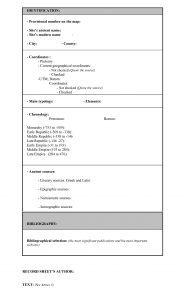The aim of this project is to produce a detailed digitised map of the Roman Empire as part of the Tabula Imperii Romani (TIR) and Forma Orbis Romani (FOR) project, driven with a new unified methodology, a centralised database shared by all countries, accessible on the internet and connected with a GIS.
To ensure that all the teams working in the different countries use the same database, sites will be identified using a systemised procedure and similar overall methodology. This common methodology has huge potential and will help us move beyond the primary aim of producing a large map of the Roman Empire (TIR) and regional archaeological maps (FOR). In the long term, unified criteria will help to compare data and to produce chronological-typological maps of the whole Empire or extensive parts of it. But this unification will also mean that the work carried out in producing the TIR can also be used for the FOR. While to date the teams working on one project or another followed different paths, with this new approach of working with a single database the FOR will end up being a more detailed production of the TIR; i.e. an extension of the same work for those regions that are particularly rich in documentation of the Roman world.
Within this same database the site record has been divided into two parts. The first part, more basic, relates to the documentation required to produce the TIR while the second part, more elaborate, refers to the material required to produce the FOR.
This is due to the fact that the aim of the TIR is to produce information on a map with a scale of 1:1,000,000 whereas the aim of the FOR is to produce maps with the scale 1:25,000.
TIR CRITERIA
In accordance with the TIR stipulations the chronological boundaries go from the Roman conquest to the 5th century AD.
The following is the most relevant information captured:

- Route of the main thoroughfares: mountain bridges and passes, milestones and mansiones. The text contains the modern place names related to the thoroughfares when there are clear remains of the paving or route, but they have not been detailed on the map to keep it simple.
- Important cities, towns.
- Indigenous settlements occupied in Roman times.
- Villae. Only those where there are still remains of the building, baths or mosaic floors.
- Isolated necropolises. Given the general criterion established there must be more than thirty graves; however, their relative importance within the overall geographical context is also taken into account.
- Significant ruins and finds.
- Noteworthy or important isolated monuments such as shrines, nymphaea, fountains, baths, dams, aqueducts, circuses, triumphal arches or beacons.
- Industrial sites: pottery kilns or workshops, trading posts, mines, quarries and saltworks.
- Sea and river ports, jetties and wrecks.
- Military camps and battlefields.
- Inscriptions. Regarding votive inscriptions, only those dedicated to indigenous gods are included. Regarding funereal inscriptions, only when found in significant numbers. Commemorative inscriptions only appear if they refer to town ordinance, members of the local ordo or military units.
- Physical geographic features, names of places or ethnic groups documented in literary or epigraphic sources.
When various symbols represent a specific phenomenon, only the most general symbol is used on the map (city or town, for example, and not theatre, necropolis, inscription, etc.). Nevertheless, the description includes elements not contained on the map. The administrative boundaries have been drawn taking the most recent bibliography available into account.
Detail of the criteria applied
In addition to identifiers for the site, this database also includes dictionaries of “typologies” and “elements” that can be related to the chronology. It therefore provides considerable flexibility that goes beyond the classic stable FOR map as both chronological-typological and element maps can be produced for sites using the same basic information.
Criteria of Authorship of the scientific archaeological entries
Every file has been created under the scientific responsibility of their authors. The author and the year of the creation appear at the end of the files. The TIR-FOR online project has a policy of updating the archaeological information. If the file has been updated the new author and the year of the revision will be indicated.
You will find the suggested citation at the end of the file.
